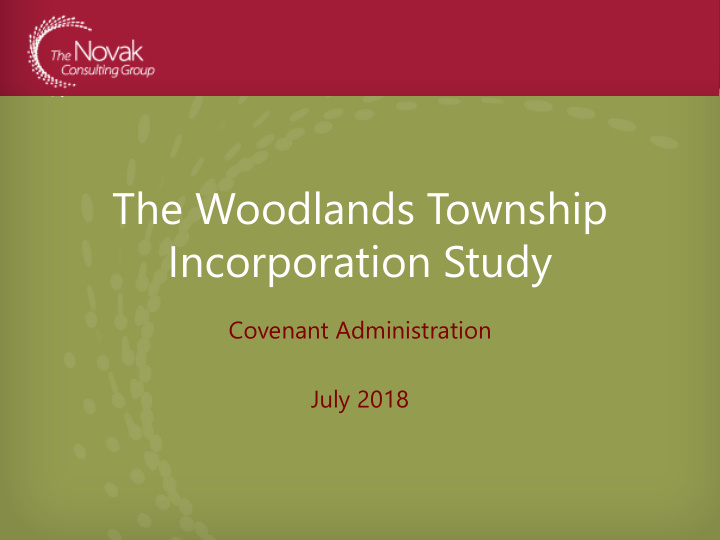



The Woodlands Township Incorporation Study Covenant Administration July 2018
Today’s Goal • Review research and findings relating to covenant administration, planning, and zoning • Frame questions the Board may wish to have the public respond to during the community input phase of the study
Decision Framework Options for Consideration: • Option 1 – Maintain covenant administration model • Option 2 – Adopt the more widely-used planning • and zoning model Option 3 – Maintain the Covenant Administration • model during the required general law city period and transition to a planning and zoning model as a phase of the charter development process To help inform the deliberation of these options, • The Novak Consulting Group conducted research around three important questions.
Decision Framework 1. What new authority or responsibilities will an incorporated Woodlands gain? Regardless of whether the City uses covenant • administration or planning and zoning 2. What is gained/lost by retaining covenant administration? 3. What is gained/lost by implementing planning and zoning?
Common Terms Covenants/Deed Restrictions • Written agreements among private owners that limit how • real property may be used Conveyed with the property according to the terms of the • deed restrictions Enforceable through civil processes • Zoning Ordinances • Enacted by a municipality • Regulate how property owners may use or develop their • properties Enforceable through civil and criminal processes • Planning Process • A municipal process to control the development of • communities through local ordinances and direct interventions
Common Terms • Nuisance Ordinances Regulate the unreasonable or unlawful use of • property Protect life, health, and safety concerns in the • community Enforceable through civil and criminal • processes • Building Review Process Enforce a building code through a plan • review and inspection process for major remodels and new construction
Authority and Responsibility Under Incorporation
New Authority/Responsibility Incorporated municipalities can regulate • life, health, safety, and construction issues unrelated to zoning/land use Accomplished through nuisance ordinances • and building code
New Authority/Responsibility Enforcement can include fines and • misdemeanor charges Criminal penalties vary • Benchmark communities prioritize • cooperative resolution over citations Civilian and sworn personnel employed • by The Woodlands could enforce nuisance ordinances
New Authority/Responsibility Upon incorporation, The Woodlands • would be required to adopt and enforce a building code These functions are currently performed by • the County
Covenant Administration
Covenant Administration State code gives municipalities ability to enforce • covenants if they do not have zoning ordinances The Woodlands can retain covenant administration • after incorporation Enforcement of covenants can only be through a • civil process Benchmark communities who operate under a • planning and zoning model also emphasize civil remedies and pursue citations as a last resort, even though they have the authority to do so The new city would not have oversight of • planning and development activities in The Woodlands.
Planning and Zoning
Planning and Zoning The zoning ordinance would have to be • more restrictive than existing covenants to be enforceable The City could not directly enforce deed • restrictions Legal Question: Are there elements of • existing covenants that could not be covered under a zoning code?
Planning and Zoning Provides capacity for additional long • range planning and development process management Would require the addition of personnel • to administer the planning and land development processes Among The Woodlands’ five benchmark • communities, an average of 13 Full Time Equivalent (FTE) positions are employed in planning functions
Planning and Zoning Planning and zoning model may offer an • opportunity to resolve covenant violations or nuisance issues in a more timely fashion Need to understand how a “more restrictive” • zoning ordinance would impact notice timeframes
Planning and Zoning The Benchmark Process Task Notes Woodlands Communities Inspect violation and mail/post initial notice 1 1 In The Woodlands, Owner given time to address violation 15 7 covenants require a 15-day waiting period Reinspection and mail/post second notice 1 1 In The Woodlands, Owner given time to address violation 15 7 covenants require a 15-day waiting period In The Woodlands, this notice is addressed to the Reinspection and post final notice 1 1 property owner from the Township’s legal counsel. Owner given time to address violation 5 5 Assumes a contractor is Abatement 7 7 available within 7 days City bills owner for abatement costs and fees 0 30 Township files suit to recover abatement costs 30 0 Assumes legal processes Liens filed 7 7 have concluded to allow filing within 7 days Total Estimated Days 82 66
Policy Questions
Questions for Public Comment Are there life, health, and safety type nuisances • you would like to regulate that The Woodlands cannot currently respond to? Is a criminal (misdemeanor) enforcement power • for code violations perceived as inherently stronger than civil enforcement mechanisms? As a new city, should The Woodlands control • development decisions in the community through planning and zoning? Are there potential development projects in The • Woodlands which cause you concern? Would you expect an incorporated city to exercise greater control over those issues?
Questions and Answers
Recommend
More recommend